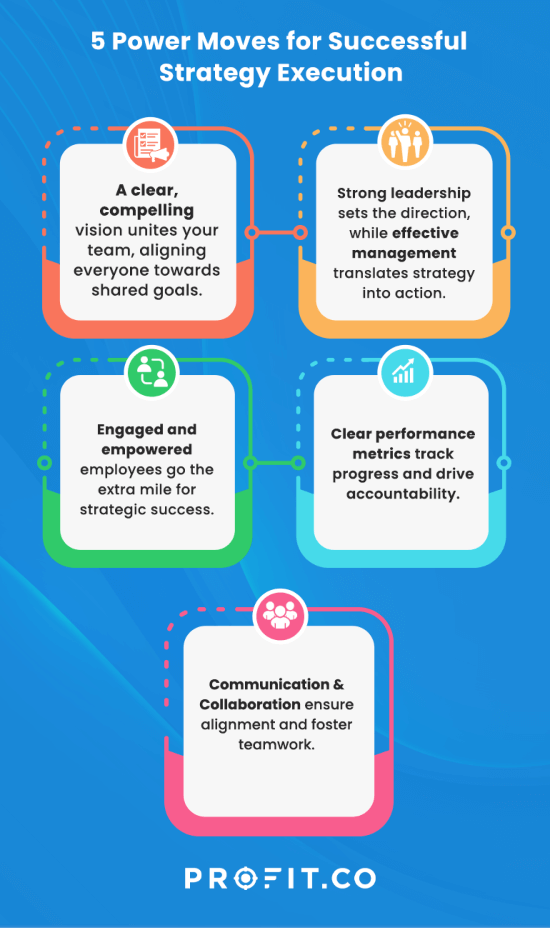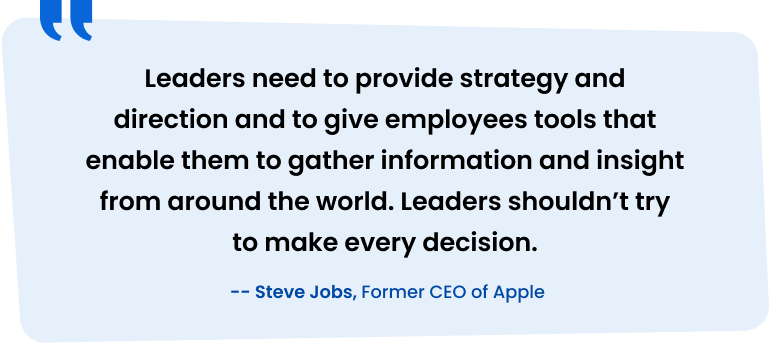Effective strategy execution bridges the gap between formulating an organizational vision and achieving the objectives. So successful strategy execution is as important as having a sound strategy. However, strategy execution is a complex process that demands careful management. The outcomes of strategy execution are influenced by numerous factors, such as choosing the right priorities, achieving organization-wide alignment, organizational culture, employee engagement, business conditions, emerging competition, resource allocation, market dynamics, technological advancements, etc.
Hence, identifying and understanding these factors is paramount for effective strategy execution. Recognizing and thoroughly understanding these factors enable you to focus on them, and prioritize and reinforce them to attain strategic success.

Following are the top five contributing factors to successful strategy execution
1. Clear and Compelling Vision
A clear and compelling vision provides a direction and a common purpose that unites all the employees in the organization. It outlines the aspirations of the organization and guides the organization toward what it must achieve and the position it wants to reach in the future. When the vision is not clearly defined, it cannot unify the employees, and it will lead to employees working in silos towards their own objectives that do not lead to the realization of the vision. It may lead to ineffective, fragmented, and disjointed strategy execution. In contrast, a well-defined vision establishes a strong foundation for the organization to enhance strategy execution and increase the likelihood of achieving its strategic goals.

A well-defined vision
- Creates a sense of shared purpose
- Aligns employees and stakeholders to a common objective
- Unites employees to work toward shared goals
- Makes employees understand how their work contributes to the bigger picture
- Connects the outcomes produced by individuals
- Motivates them to aim high, perform well, grow, and contribute towards the collective goal
- Promotes employee engagement and commitment to the strategy
- Creates ownership of the strategic objectives among employees and helps in executing business strategy smoothly
Since the vision is a unifying factor that brings stakeholders across all levels together, you must communicate the vision throughout the organization. It is indispensable for the employees to have a uniform understanding of the vision and its significance. You can impart that understanding only by consistently and transparently communicating the vision. The leaders need to effectively communicate and take the vision across the organization, down to the lowest level of the company hierarchy, to inspire and rally employees around a common cause and foster unity, collaboration, and performance.
In addition to communicating it to the employees, it is also imperative to communicate and articulate the vision with external stakeholders of the organization. It helps you attract like-minded partners, suppliers, third-party vendors, investors, and customers who share the same aspirations. Such partnerships and collaborations bound by a shared vision enable the organization to effectively build a broader network of like-minded stakeholders who will actively support and contribute to the organization in effective strategy execution and in achieving its strategic objectives.
2. Strong Leadership and Management
Strong leadership and management are crucial for effectively executing business strategy.
A strong company leadership guides the organization in the right direction, allocates resources, takes sound, data-driven decisions, and offers support in addressing challenges, thus facilitating effective strategy execution.

Strong leadership
- Inspires and motivates employees
- Sets the tone and direction for the organization toward the strategic objectives
- Fosters a sense of purpose and commitment to the strategy
- Communicates the vision, values, and strategic priorities of the organization with all the stakeholders
- Creates a culture of transparency and accountability top-down
- Drives innovation and creative thinking to find solutions and workarounds to overcome challenges
- Promotes continuous improvement and a performance culture
- Supports strategy execution and makes data-driven strategic decisions to adapt and adjust to emerging challenges in a timely manner
- Helps the workforce navigate challenges, obstacles, and uncertainties
To set these high standards in driving the organization forward and inspiring and guiding the employees toward strategic success, the leaders should possess the following skills and qualities. They should:
- Have the mindset of a visionary
- Be able to think strategically
- Know how to communicate the vision across the organization, impart a thorough understanding, and inspire others
- Be decisive, adaptable, and strong in the face of challenges
- Possess extraordinary interpersonal skills and the ability to build relationships
- Foster teamwork, partnership, and collaboration with various stakeholders
While the company leadership remains at the top without getting into the specifics of strategy implementation or the day-to-day affairs of the organization, the management takes a hands-on approach when it comes to strategy execution. An effective team of managers constantly verifies the alignment of employees to the strategic objectives, translates strategy into action, coordinates the teams, motivates the employees, measures the performance and tracks the progress of employees, the organization, and the strategic initiatives, and acts as a catalyst in consolidating the efforts of individuals and teams into meaningful outcomes.

The Management
- Directs the strategy execution, manages resources, and offers hands-on support
- Translates the strategic objectives from a conceptual level into actionable plans
- Sets goals and targets and defines the KPIs and performance measures
- Ensures the availability of adequate human, financial, and technological resources to the right strategic priorities
- Arranges training and development opportunities
- Monitors progress, tracks performance, and makes necessary adjustments for effective strategy execution
Strong leadership, in conjunction with effective management, drives the organization toward successful strategy execution.
Ready to start your OKR journey for FREE?
3. Employee engagement and empowerment
Successful strategy execution requires active participation from the employees and the ownership of the strategy. These are possible only when the employees are passionate about their work and are willing to go beyond their defined roles and responsibilities to fulfill strategic objectives. Therefore it is indispensable to focus on increasing employee engagement in the organization.

Employee engagement
- Kindles intrinsic motivation and passion among employees about their work
- Inspires employees to find purpose and fulfillment in their work without requiring active management
- Makes employees understand the importance of their work and ensures that the outcomes they produce align with the strategic objectives
- Provides the drive and motivation to excel in productivity and performance
- Leads to increased commitment
- Instills a strong sense of loyalty towards the organization and the internalization of its strategic objectives
- Inspires employees to act as the torchbearers of the values and vision of the organization, ultimately motivating them to go the extra mile to fulfill strategic goals
While employee engagement prepares employees for successful strategy execution, they cannot fully realize their potential unless they are empowered to act without active supervision. So employee empowerment complements employee engagement in strategy execution.
Employee empowerment
- Entitles employees with the autonomy, authority, and resources to make decisions independently within the purview of their role and job position
- Makes employees feel trusted and valued, thus enhancing accountability
- Enables employees to take the initiative, operate independently, be creative, and make decisions that positively impact strategy execution
- Promotes a culture of innovation and continuous improvement
- Encourages participation and brings diverse perspectives and knowledge into strategy execution
- Instills innovation and adaptability in the organization
4. Clear Performance Metrics and Accountability
Performance metrics provide a framework for measuring progress against strategic goals and tracking performance. They also help evaluate the effectiveness of the strategy and the strategic initiatives. They enable organizations to make informed decisions for effective strategic execution. By establishing a robust system of performance metrics, organizations can track their advancement, drive continuous improvement, and achieve their strategic goals effectively.

Following are the steps in establishing and measuring performance metrics.
a. Establish goals and KPIs:
For successful strategy execution, you must have clear strategic goals and measurable targets. In addition to the goals and targets, you must have relevant Key Performance Indicators (KPIs) for monitoring your progress against the strategic goals, evaluating the performance of your strategy, and identifying areas that require adjustment. KPIs help ensure that strategy execution drives the organization toward the desired outcomes.
b. Track performance and drive progress:
Leaders and managers constantly measure the KPIs to track the progress toward the strategic goals and assess if the strategy execution is yielding desired results. Tracking KPIs enables the leaders to proactively identify any anomalies, deviations, and challenges and take corrective actions in a timely manner. It helps them sustain the momentum, ensure alignment with the strategy, and allocate resources effectively to high-priority strategic initiatives.
c. Establish accountability at all levels:
Since KPIs help to quantify and measure progress, they set clear targets and benchmarks for individuals, teams, and the organization. They set expectations for employees and clarify the outcomes expected from them. So the employees start with a clear target and take responsibility for their outcomes. This fosters accountability throughout the organization and creates a culture of ownership, thus driving performance and excellence in executing business strategy.
d. Improve and Adapt:
Through data analytics and detailed insights from these metrics, organizations can identify areas that require improvement and allocate or reallocate resources accordingly. They can make informed decisions, change the strategic priorities to adapt to the changing conditions, proactively address emerging challenges and refine the strategy continuously.
5. Effective Communication and Collaboration
Effective communication and collaboration have a significant impact on strategy execution by ensuring:
- Alignment to the strategic goals and coordinated, synergetic work across the organization, leading to a concerted effort in executing business strategy
- A thorough, shared understanding of the strategy, strategic objectives, the rationale behind the strategy, and the implications of strategy execution, which leads to ownership of strategy and informed decision-making
- A culture of teamwork, participation, cross-functional collaboration, extensive knowledge and information sharing, and innovation
- Employee engagement and buy-in, as the employees feel valued when they are constantly informed about the progress against strategic goals and their contribution acknowledged
- Continuous learning derived from employee feedback and mistakes and applying those learnings for constant improvement in strategy execution

How can OKRs Help?
Objectives and Key Results (OKRs) are a powerful tool that can significantly enhance the effectiveness of strategy execution across all the above five key areas.
- They transform your organization’s vision into actionable objectives, providing a clear path toward achieving strategic goals.
- They offer leaders a structured framework for setting ambitious goals, monitoring progress, and making informed, data-driven decisions.
- OKRs foster employee engagement by providing each team member with clear, aligned goals that contribute to the organization’s vision, creating value and empowerment.
- They act as a robust performance-tracking system, offering clear, measurable metrics that foster accountability at all levels.
- OKRs facilitate open communication and collaboration within your organization, ensuring everyone is aligned and working towards the same objectives.
OKRs provide a structured, measurable, and collaborative approach to achieving your strategic goals, making them invaluable for successful strategy execution.
Frequently Asked Questions
1. What are the different types of strategy execution?
Following are the different types of strategy execution.
- Top-down execution
- Bottom-up execution
- Agile execution
- Collaborative execution
- Performance-driven execution
- Innovation-driven execution
- Customer-centric execution
2. What are the four levels of corporate strategy?
The four levels of corporate strategy are:
- Corporate-Level Strategy
- Business-Level Strategy
- Functional-Level Strategy and
- Operational-Level Strategy
3. What are the five processes of making and executing a strategy?
The five processes of making and executing strategy are:
- Environment analysis
- Strategic planning
- Strategy formulation
- Strategy implementation
- Evaluation and control
Final Thoughts
In conclusion, OKRs are not just a tool but a game-changer for any organization aiming for successful strategy execution. They provide a clear roadmap, aligning everyone’s efforts towards a shared vision. They empower leaders, engage employees, and foster a culture of accountability and collaboration. With OKRs, you’re not just executing a strategy; you’re creating a movement where every team member contributes to the organization’s success. So, whether you’re a startup finding your footing or an established company looking to level up, embracing OKRs can be the catalyst that propels your organization to new heights of success.
